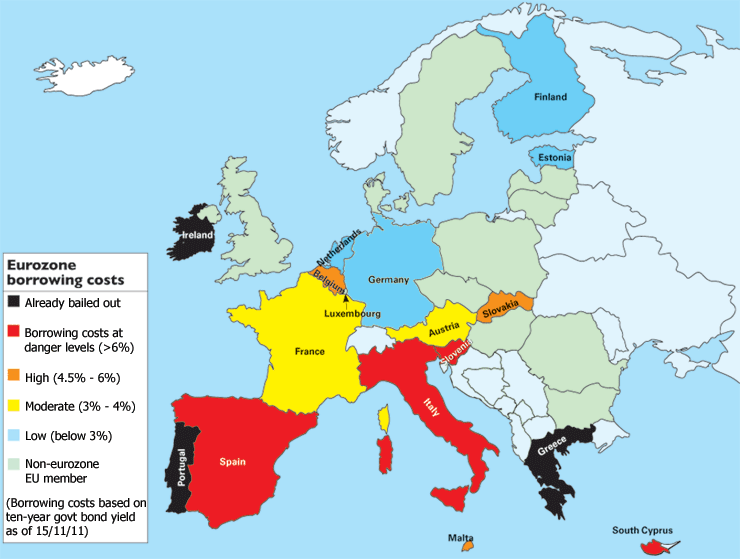
In the eurozone crisis so far, 6.5% has proved a fateful number. Once a country has seen its cost of borrowing (as measured by the yield on its ten-year bonds) rise above 6.5% a year, a bail-out has inevitably followed. That was the case for Greece, Ireland and Portugal. Now Italy’s borrowing costs have passed the point of no return, rising to more than 7% last week.
Italy is not in the same situation as Greece. It is Europe’s third-largest economy, with a strong manufacturing sector; relatively sound, conservative banks; and less of a problem with tax evasion. While the country is heavily indebted (its debt-to-GDP ratio is 120%, second only to Greece), its annual deficit (overspend) is small compared with other European countries (including the UK). It amounts to a manageable 4.6% of GDP.
Italy’s main problem is that it can’t grow its economy rapidly enough to dig its way out of debt. During its time within the eurozone, the economy has stagnated, with GDP per head falling throughout the 2000s. What the economy needs is structural reform, asset sales, and tougher austerity measures, all of which new prime minister Mario Monti will try to push through. But this takes time, and the markets aren’t in a patient mood. With Italy far too big to save using the current eurozone bail-out fund, ‘contagion’ looks set to spread rapidly unless the European Central Bank (ECB) steps in far more aggressively than it has so far.
Spain is the other big immediate concern. While Spain’s debt-to-GDP is fairly low at around 65%, its annual deficit is unsustainably high – it’s expected to come in at 6.6% this year. The collapse of the property bubble has also left its banks in a mess – plans to help the banks, says UBS, could result in “a surge of liabilities being transferred to the government balance sheet”.
A few smaller eurozone members – Cyprus and Slovenia – have also seen their bond yields rise into the danger zone. However, after Italy and Spain, the next country to watch is France.
While French borrowing costs remain well below 4%, the country is seen as vulnerable, as evidenced by the reaction to a ‘mistaken’ downgrade by credit-ratings agency Standard & Poor’s and a threatened downgrade by Moody’s. If markets panic about France, there really would be no alternative but for either the euro to break up, or the ECB to agree to print money.